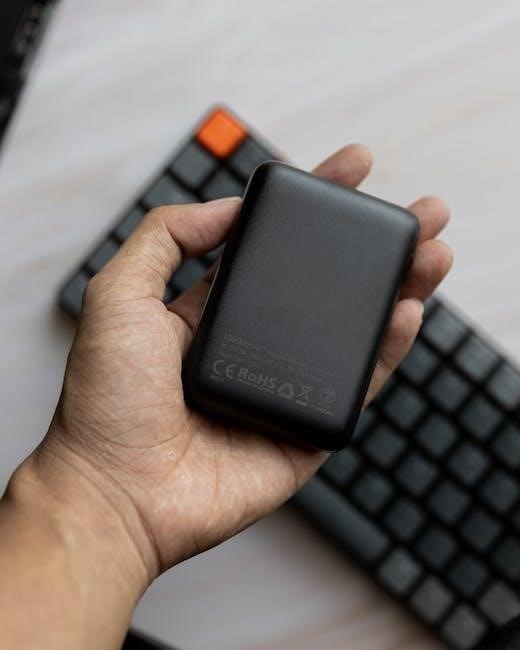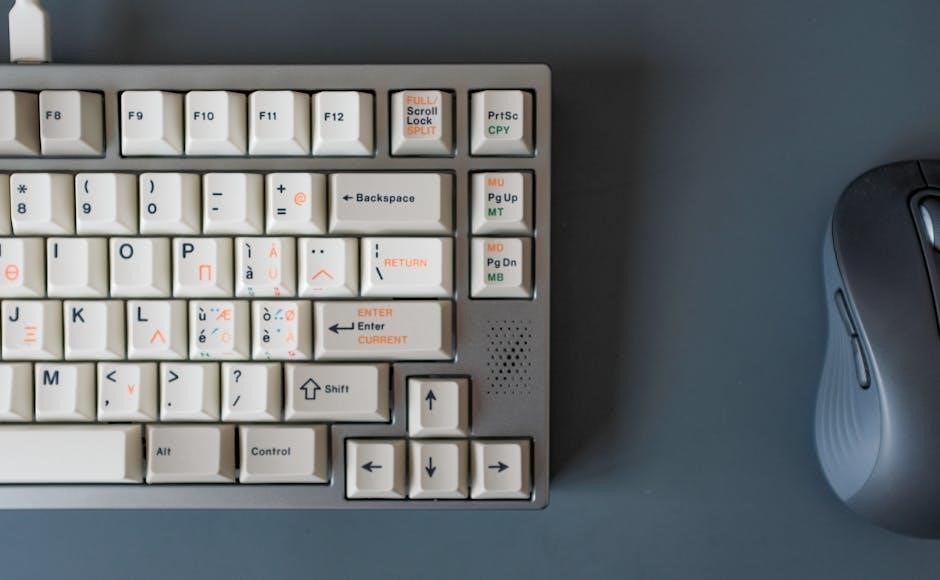
button battery size guide
Button batteries are small, round batteries used in various devices, such as watches, toys, and medical devices. Their size is crucial for compatibility and performance.
1.1 What Are Button Batteries?
Button batteries, also known as coin batteries, are small, round batteries used to power devices like watches, calculators, and hearing aids. They are named for their button-like shape and are typically made of metals like lithium, silver-oxide, or alkaline. Available in various diameters and thicknesses, they provide reliable power for low-drain devices. Their compact size and long lifespan make them indispensable for everyday electronics;
1.2 Importance of Button Battery Sizes
Button battery size is critical for safety and functionality. Incorrect sizes can cause devices to malfunction or batteries to rattle, leading to reduced performance. Proper fit ensures reliable power delivery and prevents safety hazards. Using the wrong size can also pose risks, especially to children, if batteries are swallowed. Correct sizing ensures optimal device operation and minimizes potential dangers, making it essential to choose the right size for your needs.
Common Button Battery Sizes
Button batteries come in various standard sizes, with diameters ranging from small to large. They power devices like watches, toys, and medical gadgets, ensuring reliable performance.
2.1 Popular Button Battery Types (e.g., CR2032, LR44, SR44)
The CR2032 is a lithium battery, commonly used in devices like calculators and watches, offering high energy density. The LR44 and SR44 are alkaline and silver-oxide batteries, respectively, widely used in watches, toys, and hearing aids. Each type has distinct voltage and lifespan, making them suitable for specific applications, ensuring optimal performance in various devices.
2.2 Dimensions and Voltage of Each Size
Button batteries vary in size, with the CR2032 measuring 20mm in diameter and 3;2mm in thickness, operating at 3V. The LR44 is 11.6mm in diameter and 5.4mm thick, providing 1.5V, while the SR44, similar in size, offers 1.55V. These dimensions and voltages ensure compatibility with specific devices, making precise measurement and selection crucial for proper functionality and performance.
How to Measure Button Batteries
Use calipers to measure diameter and thickness accurately. Check voltage with a multimeter to ensure compatibility. Record these details for proper device fitting and performance.
3.1 Tools Needed for Measuring Battery Size
To measure button batteries, you’ll need digital calipers for precise diameter and thickness measurements. A multimeter can check voltage, ensuring compatibility. A ruler or gauge may suffice for basic sizing. A magnifying glass or loupe can help inspect tiny engravings. Always reference the device’s datasheet for exact specifications to ensure accurate measurements and proper fitment.
3.2 Step-by-Step Measurement Guide
Prepare the battery and tools, ensuring the battery is flat side up. Use digital calipers to measure diameter and thickness.
Measure the diameter across the battery’s widest point and record the thickness from the flat side to the top.
Use a multimeter to verify voltage, ensuring it matches the device’s requirements.
Refer to the device’s datasheet for exact size specifications.
Compare your measurements to standard button battery sizes for accurate identification.

Safety Tips for Handling Button Batteries
Handle button batteries with care to avoid injuries. Store them in a cool, dry place, out of children’s and pets’ reach. Check for damage before use and ensure proper disposal. Use protective covers when not in use and avoid mixing old and new batteries. Always recycle batteries responsibly.

4.1 Risks of Swallowing Button Batteries
Swallowing button batteries is extremely dangerous, especially for children and pets. The batteries can cause severe burns, perforate internal tissues, and lead to life-threatening injuries. Immediate medical attention is critical. Symptoms may include vomiting, abdominal pain, and difficulty breathing. If ingestion is suspected, act swiftly to prevent fatal outcomes.
4;2 Safe Storage and Disposal Practices
Store button batteries in a secure, out-of-reach location, ideally in their original packaging. Tape battery terminals to prevent accidental discharge. Dispose of used batteries at designated recycling centers to avoid environmental harm. Never incinerate batteries, as they release toxic chemicals. Proper disposal ensures safety and reduces ecological impact.

Button Battery Applications
Button batteries power devices like watches, calculators, hearing aids, toys, and remote controls. Their compact size and reliable energy make them essential for everyday and specialized electronics.
5.1 Devices That Commonly Use Button Batteries
Button batteries are widely used in devices like watches, calculators, hearing aids, and small toys. They also power remote controls, fitness trackers, and medical devices. Their compact size and reliable voltage make them ideal for these applications. Common battery types, such as CR2032 and LR44, are frequently used in everyday electronics due to their energy efficiency and long lifespan.
5.2 Specialized Uses in Medical and Industrial Devices
Button batteries are essential in medical devices like pacemakers, insulin pumps, and hearing aids, where reliability and compact size are critical. In industrial settings, they power sensors, IoT devices, and automated systems. Their high energy density and consistent voltage ensure long-term performance in specialized applications, making them indispensable for both life-saving and industrial operations.
Button Battery Hazards
Button batteries pose significant risks, especially to children and pets if ingested, and improper disposal can harm the environment, highlighting the need for safe handling and disposal practices.
6.1 Dangers to Children and Pets
Button batteries pose severe risks to children and pets if ingested. They can cause internal burns due to chemical reactions, leading to serious injury or death. Immediate medical attention is critical. Small size and curiosity make children vulnerable to swallowing batteries, while pets may mistake them for food. Parents and caregivers must remain vigilant to prevent such accidents, ensuring batteries are stored securely out of reach.
6.2 Environmental Impact of Improper Disposal
Improper disposal of button batteries harms the environment. Heavy metals like mercury and lithium can leach into soil and water, contaminating ecosystems and posing risks to wildlife. These toxins can accumulate in the food chain, affecting both plants and animals. Proper recycling and disposal methods are essential to mitigate this environmental damage and protect natural resources for future generations.
Choosing the Right Button Battery

Selecting the correct button battery involves checking compatibility, voltage, and device requirements. Ensure the battery size and type match your device for optimal performance and safety.
7.1 Matching Battery Size to Your Device
Matching the battery size to your device ensures proper function and safety. Always refer to the device’s manual or manufacturer’s specifications to confirm the required battery type and size. Using the wrong size can cause malfunctions or safety risks. Measure the battery compartment or check the device’s label for precise dimensions and voltage requirements. This step is essential for optimal performance and reliability.
7.2 Understanding Battery Capacity and Lifespan
Battery capacity, measured in milliampere-hours (mAh), indicates how much energy a button battery can store. Higher capacity means longer device operation. Lifespan depends on usage, device power demands, and environmental factors like temperature. Proper storage and handling extend lifespan. Always choose batteries with capacities suited to your device’s needs for optimal performance and longevity, ensuring reliable operation over time.

Recycling and Disposal Guidelines
Recycling button batteries is crucial for environmental safety. Check local regulations for designated recycling centers. Do not dispose of batteries in regular trash or landfills.

8.1 How to Recycle Button Batteries
Recycling button batteries requires careful handling. Start by gathering used batteries and sorting them by type. Tape terminal ends to prevent short circuits. Locate a local recycling center or retailer that accepts button batteries. Follow their specific guidelines for proper disposal. Do not crush or puncture batteries. Always adhere to safety precautions to minimize environmental impact and ensure responsible recycling practices.
8.2 Local Regulations for Battery Disposal
Local regulations for battery disposal vary by region. Check with your municipal government for specific guidelines. Many areas require separating button batteries from household waste due to their toxic materials. Use protective coverings or tape terminals to prevent short circuits. Participate in community collection programs or drop-off locations. Proper disposal ensures environmental safety and compliance with local laws, reducing hazardous waste impact.

Future Trends in Button Batteries
Advancements in button battery technology focus on improving energy efficiency and safety. Eco-friendly materials and sustainable designs are being developed to reduce environmental impact and enhance performance.
9.1 Advancements in Battery Technology
Recent advancements in button battery technology include the development of solid-state batteries and improved lithium-ion designs. These innovations enhance energy storage, reduce size, and increase safety. Researchers are also exploring eco-friendly materials to minimize environmental impact while maintaining performance. Additionally, advancements in manufacturing processes aim to improve battery lifespan and reliability, ensuring button batteries meet the growing demands of modern devices.
9.2 Eco-Friendly Alternatives to Traditional Button Batteries
Eco-friendly alternatives to traditional button batteries include zinc-air batteries and solid-state designs. These options reduce toxicity and environmental impact while maintaining performance. Researchers are also developing batteries with recyclable materials, minimizing waste. Additionally, advancements in rechargeable button batteries are gaining traction, offering a sustainable solution to single-use batteries; These innovations aim to address environmental concerns without compromising functionality or size requirements.
Understanding button battery sizes and handling them safely is crucial for optimal performance and user safety. Always choose the right size and follow proper care guidelines.
10.1 Key Takeaways from the Guide
Button batteries vary in size, voltage, and capacity, each suited for specific devices. Correct sizing ensures functionality, while safe handling and disposal prevent hazards. Always verify compatibility and follow storage guidelines to avoid risks, especially for children and pets. Proper recycling is essential for environmental protection. Remember, choosing the right battery prolongs device life and ensures safety.

10.2 Final Tips for Safe and Effective Use
Always verify battery size and voltage before installation to ensure compatibility. Store batteries securely, away from children and pets, and recycle them properly. If a battery is swallowed, seek immediate medical attention. Check for expiration dates and signs of damage before use. Follow device manufacturer guidelines for optimal performance and safety. Remember, proper handling and disposal are key to preventing hazards and extending battery life.